Where Are the Green Jobs for Women?
Tiffany Bluemle, Executive Director, Vermont Works for Women; Camille Cormier, Director of Local Programs and Policy, Wider Opportunities for Women; Debbie Frett, CEO, Business and Professional Women's Foundation; Virginia Joyce, Vice President, ResCare Employment & Training Services Group; Joan Kuriansky, Executive Director, Wider Opportunities for Women; Yvonne Liu, Senior Research Associate, The Applied Research Center; Sara Manzano-Diaz, Director of the Women's Bureau, U.S. Department of Labor; Michele Parrott, Women in Non-Traditional Employment Roles; Shari Shapiro, Lawyer and Author, Philadelphia; Kit Williams, Project Manager, Green Jobs Pipeline for Women, Alliance for Sustainable Colorado; Wanda Ward, Office of the Director, National Science Foundation
Overview
Speakers:
Tiffany Bluemle, Executive Director, Vermont Works for Women; Camille Cormier, Director of Local Programs and Policy, Wider Opportunities for Women; Debbie Frett, CEO, Business and Professional Women's Foundation; Virginia Joyce, Vice President, ResCare Employment & Training Services Group; Joan Kuriansky, Executive Director, Wider Opportunities for Women; Yvonne Liu, Senior Research Associate, The Applied Research Center; Sara Manzano-Diaz, Director of the Women's Bureau, U.S. Department of Labor; Michele Parrott, Women in Non-Traditional Employment Roles; Shari Shapiro, Lawyer and Author, Philadelphia; Kit Williams, Project Manager, Green Jobs Pipeline for Women, Alliance for Sustainable Colorado; Wanda Ward, Office of the Director, National Science Foundation
Although the "Green Economy" holds great promise for the United States, women are significantly underrepresented in this new and growing workforce. Why is this so? The Wilson Center's United States Studies Program hosted a conference to explore this question.
The conference began with an introduction by Sonya Michel, Director of United States Studies at the Wilson Center. Michel highlighted the fact that green jobs are one of the few bright spots in an otherwise bleak job market, but she warned that the promise of green jobs cannot be fulfilled unless they are equally distributed between men and women. The barriers to women's entry into the green economy are similar to those faced in the 1970s when women began taking on non-traditional jobs in male-dominated fields. 
In her keynote address, Sara Manzano-Diaz outlined her vision for women in green jobs and said it was part of the wider goals of the Women's Bureau. The agency is committed to achieving equal pay for women, promoting workplace flexibility, and serving the employment needs of women veterans. In addition to these initiatives, Manzano-Diaz highlighted the need to get women into higher paying jobs across the board. This will require them to enter into non-traditional, as well as science, technology, engineering, and mathematics (STEM) fields. But for women to become fully integrated into the growing green labor market, Manzano-Diaz emphasized, women will have to get in on the ground floor.
According to Manzano-Diaz, green jobs offer opportunities for women at many different ages and levels of skill or education. The Women's Bureau has partnered with several of the groups represented at the conference to advance green jobs projects across the country. Manzano-Diaz expressed the hope that these partnerships, combined with the Bureau's upcoming publication "Women's Guide to Green Jobs," will help to inform women about the prospects for good jobs in the green economy.
In her view, green jobs for women are not just an end in themselves. "By empowering women," she noted, "we are empowering families and by empowering families we are empowering our own economy...not only as individuals, or as families, but as a whole."
PANEL I: National Trends
Drawing on her work as CEO of Business and Professional Women Foundation, Deborah Frett focused on the practical issues involved in empowering women to enter the green workforce. She countered the assertion that women are not interested in green jobs; rather, she said, the problem is one of increasing demand. Citing a project funded by the Wal-Mart Foundation, she noted that once women are aware of green jobs and their advantages, interest grows. This is borne out by high retention rates among women who do enter green fields.
In order to continue these successes, Frett stressed the importance of tailoring job training to meet the needs of clients. In working with women veterans in Philadelphia, she discovered that women who had served in the military were hesitant to continue in the male-dominated fields found in the "green economy." Continued success, she noted, depends on women internalizing "green thinking" so that it is incorporated into all jobs, "not only building wind turbines...but by helping a company and a family lighten its footprint."
Yvonne Liu of the Applied Research Center (ARC), asked, "Where are the women of color in the green economy?" In answering this question, Liu noted that this group is even less represented in green jobs than other women, but that the green economy has the potential to reverse some of the ills of the previous "gray economy" when it comes to women's ethnic and racial equality in the workplace.
Liu described ARC's Green Equality Toolkit, which sets out the principles that green jobs should include, not just for women, but for all people of color. These jobs should be secure as well as sustainable and should provide the potential for advancement. In order to achieve these goals, Liu argued that the definition of what constitutes a green job must be redefined, according to the particular needs and wants of the local population. The green economy is not automatically equitable; it must be made so. Only with intentional action and strict enforcement will it fulfill its promise.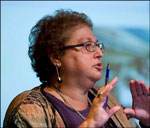
Continuing the theme of strategies for green job creation, Joan Kuriansky, executive director of Wider Opportunities for Women (WOW), described how promoting a green economy on the local level helps to make jobs more inclusive. Those in positions of leadership must work to build the green economy in their communities. Echoing Liu's comments, Kuriansky stressed the importance of strictly enforcing laws and agreements already in place and creating incentives for employers to be inclusive in their hiring of women.
Kuriansky also challenged the audience to think differently about the relationship between women and green jobs. "We spend a lot of time talking about why green jobs are good for women," she said. "I want us to realign that paradigm and consider why women are great for green jobs."
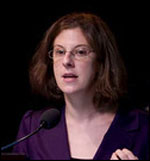
Several panelists noted that one of the barriers to women's entry into the green economy is the high number of jobs in the STEM (science, technology, engineering, and math) fields, where women are already underrepresented. Wanda Ward of the National Science Foundation (NSF) presented insights into why this is so. The primary reason, she said, is family responsibilities, which make it difficult for women for women to pursue education and training in those fields.
The NSF is actively working on both green initiatives and the promotion of women in STEM disciplines. Ward hopes that the advancement of women in academic positions in STEM can provide role models and direction for future generations of women scientists. This, along with the promotion of family-friendly policies through NSF's ADVANCE grant program, is creating a greater role for women in the science fields that are so crucial to green job development.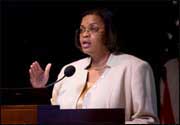
Shari Shapiro, an environmental lawyer and author, addressed the topic of white- collar green jobs. Because women are customarily underrepresented at this level, it is even more difficult for them to enter such jobs in the green economy. However, Shapiro pointed out, those women who are in positions of economic leadership have the potential to advance the cause of women in the green economy. Women-owned businesses are the fastest growing the in U.S., and women tend to hire women. Shapiro sees this as a way to quickly grow green jobs for women in a supportive, family-friendly environment. This initiative can be promoted by reserving a proportion of projects and contracts specifically for women-owned businesses.
PANEL II: Women's Pathways to the Green Economy
Camille Cormier, Director of Local Programs and Policy for WOW in Washington, D.C. underscored earlier comments with reference to WOW's D.C. construction training programs for women. She observed that the economic crisis has made construction jobs scarce even for existing male workers, The DC Green Building Act, passed in 2006, creates a huge potential market for green construction and WOW is trying to ensure that women benefit equally from the construction revenue it may generate. But this will require, among other things, strict attention to enforcement of gender equity regulations.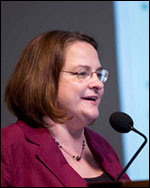
Michele Parrott, Green Jobs Program Coordinator for Women in Non-Traditional Employment Roles (WINTER), discussed her organization's experience with green job training. She emphasized that job training alone does not guarantee success in the real-world economy. Strong, confident candidates are needed to deal with the inherent challenges of the non-traditional workforce. Parrott agreed that green jobs have been difficult to find, even for qualified trainees, although it is anticipated that growth will come with economic recovery.
Parrott noted that education was another component of WINTER's training strategy. Teaching women about the environmental issues that underlie green jobs instills confidence that a green job is not just employment, but "a career that I know is going to help my family in the future."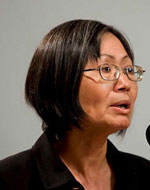
Offering an on-the-ground perspective on creating green jobs in Colorado was Kit Williams of the Green Jobs Pipeline for Women, part of the Alliance for Sustainable Colorado. The state has established infrastructure for green industry but has no history of including underrepresented populations in those jobs. After surveying conditions in the state, the Pipeline was able to tailor green job creation to the specific needs in that state.
Williams found that "green" is positioned to become the next technological revolution. "It [will become] so much a part of our life that all of us have green jobs," she predicted. For this reason, Williams' project concentrated not on training women for specific industries but on centralizing resources and information to promote equal access. Leveraging the resources of Women in Solar Energy (WISE) and Women of Wind Energy (WoWE), the Pipeline was able to provide better access to women already in green industries. Also important is "greening" women's resumes, in order to put them in the best possible position to gain access to the best jobs.
A small-state prospective came from Tiffany Bluemle, Executive Director of Vermont Works for Women. Her organization has incorporated green themes into programs beginning with young girls. Bluemle emphasized the types of work done by her organization that are specifically tailored to Vermont. These include weatherization, home-energy audits, and the installation of solar trackers that are able to maximize solar energy capture at latitudes that receive less sun. Vermont's weak economy made it necessary for the organization to engage in direct job creation by starting up its own self-sustaining enterprise. While this approach entailed some risk for the organization, it has had the added benefit of providing crucial on-the-job training for women.
Bluemle concluded her remarks by outlining the steps needed to change the current state of green jobs:
o educating girls, funding pre-apprenticeship training for women
o supporting retention activities for women in the industry
o reemphasize the role of trades in our culture
o finding male champions to influence funding and job creation for women
Virginia Joyce, Senior Director for Green Jobs and Special Initiatives at ResCare, closed the discussion by discussing her role as a job-raining professional. She pointed to the need for broader education in the general public about green jobs; skeptics need to be convinced that green jobs are "real." As evidence, she noted that in the sectors of Energy Efficiency (EE) and Renewable Energy (RE), the number of jobs is expected to grow by about 30 million in the next 20 years. Venture capital has also increased in the green economy while falling across all other sectors. Joyce voiced her support for portable credentials, which will allow for individuals to move between jobs in the green economy, without the need for continual retraining.
By Andrew Bedell
Sonya Michel, Director of United States Studies
Documents & Downloads
- Where Are the Green Jobs for Women?Download
- Where Are the Green Jobs for Women?Download
- Where Are the Green Jobs for Women?Download
- Where Are the Green Jobs for Women?Download
- Where Are the Green Jobs for Women?Download
- Where Are the Green Jobs for Women?Download
- Where Are the Green Jobs for Women?Download
- Where Are the Green Jobs for Women?Download
- Where Are the Green Jobs for Women?Download
- Where Are the Green Jobs for Women?Download
- Where Are the Green Jobs for Women?Download
- Where Are the Green Jobs for Women?Download
- Where Are the Green Jobs for Women?Download
- Where Are the Green Jobs for Women?Download
Thank you for your interest in this event. Please send any feedback or questions to our Events staff.










